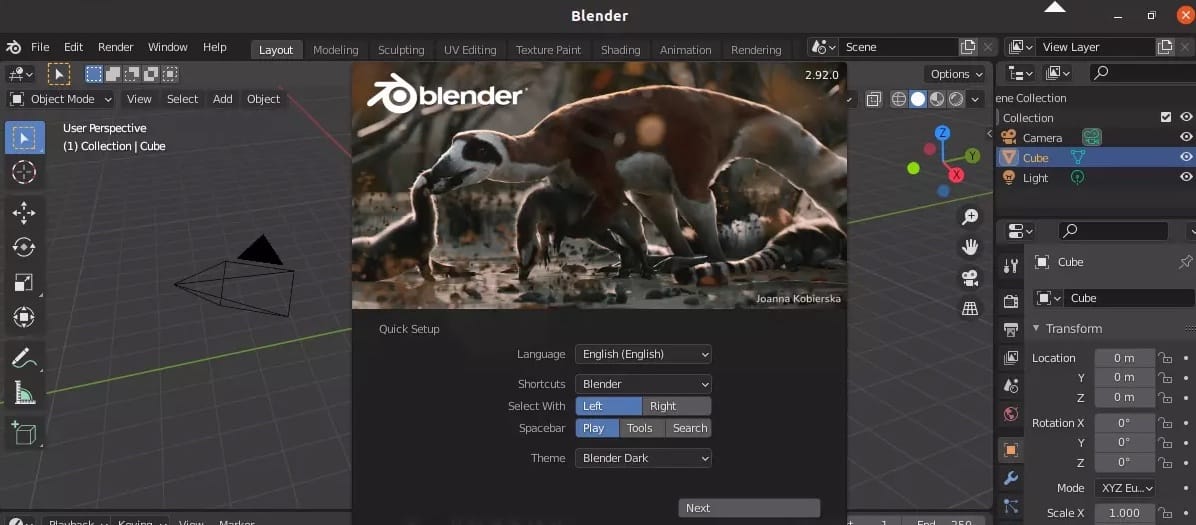How To Install Blender on Manjaro

Blender, the powerful open-source 3D creation suite, has become an essential tool for artists, designers, and hobbyists alike. When combined with Manjaro, a user-friendly and robust Linux distribution, it creates a formidable platform for 3D modeling, animation, and rendering. This guide will walk you through the process of installing Blender on Manjaro, ensuring you can harness the full potential of this software on your Linux system.
Whether you’re a seasoned 3D artist transitioning to Linux or a Manjaro user looking to explore the world of 3D graphics, this article will provide you with multiple methods to get Blender up and running on your system. We’ll cover everything from simple graphical installations to more advanced command-line techniques, ensuring that you can choose the method that best suits your needs and expertise level.
Understanding Blender and Manjaro
What is Blender?
Blender is a free and open-source 3D creation suite that supports the entire 3D pipeline – modeling, rigging, animation, simulation, rendering, compositing, and motion tracking. It also offers video editing and 2D animation capabilities. Blender’s versatility and powerful features have made it a favorite among professionals and hobbyists in various industries, including film, animation, and game development.
What is Manjaro?
Manjaro is an Arch Linux-based distribution known for its user-friendliness and stability. It combines the power and flexibility of Arch Linux with an easy-to-use interface and pre-configured desktop environments. Manjaro’s rolling release model ensures that users always have access to the latest software versions, making it an excellent choice for developers and content creators.
Why use Blender on Manjaro?
Combining Blender with Manjaro offers several advantages:
- Performance: Manjaro’s optimized kernel and lightweight nature provide excellent performance for resource-intensive tasks like 3D rendering.
- Up-to-date software: Manjaro’s rolling release model ensures you always have access to the latest Blender versions and features.
- Customizability: Both Blender and Manjaro offer extensive customization options, allowing you to tailor your workflow to your specific needs.
- Community support: Both projects have active and helpful communities, providing resources and assistance when needed.
Preparation Before Installation
Before we dive into the installation process, it’s crucial to prepare your system to ensure a smooth experience.
System Requirements
While Blender can run on a wide range of hardware, for optimal performance, consider the following recommendations:
- 64-bit quad core CPU
- 8 GB RAM (16 GB or more for complex scenes)
- OpenGL 3.3 compatible graphics card with 2 GB RAM
- Full HD display
- Three-button mouse or pen+tablet
Backing Up Your Data
Before making any significant changes to your system, it’s always wise to back up your important data. While the installation process is generally safe, unforeseen issues can occur. Use Manjaro’s built-in backup tools or your preferred backup solution to create a copy of your essential files.
Updating Your System
Ensure your Manjaro system is up-to-date before proceeding with the Blender installation. Open a terminal and run the following commands:
sudo pacman -SyuThis command will update your system packages to their latest versions, reducing the likelihood of compatibility issues during the Blender installation.
Method 1: Installing Blender via Pamac (Add/Remove Software)
The simplest way to install Blender on Manjaro is through the graphical package manager, Pamac, also known as “Add/Remove Software.”
Opening Pamac
1. Click on the Manjaro menu (usually in the bottom-left corner of the screen)
2. Search for “Add/Remove Software” or “Pamac”
3. Click on the application to open it
Searching for Blender
1. In the Pamac window, use the search bar at the top
2. Type “Blender” and press Enter
3. You should see Blender listed in the search results
Installing Blender
1. Locate Blender in the search results
2. Click on the “Install” button next to Blender
3. If prompted, enter your password to authorize the installation
4. Wait for the installation to complete
Verifying the Installation
1. Once the installation is complete, close Pamac
2. Open the Manjaro menu
3. Search for “Blender”
4. Click on the Blender icon to launch the application
If Blender launches successfully, congratulations! You’ve installed Blender using the graphical method.
Method 2: Installing Blender via Command Line
For users comfortable with the terminal, installing Blender via the command line can be quick and efficient.
Opening the Terminal
1. Press Ctrl+Alt+T to open the terminal, or
2. Search for “Terminal” in the Manjaro menu and click to open it
Updating Package Lists
Before installing Blender, ensure your package lists are up-to-date:
sudo pacman -SyInstalling Blender using pacman
To install Blender, run the following command:
sudo pacman -S blenderThe system will prompt you to confirm the installation. Type ‘Y’ and press Enter to proceed.
Verifying the Installation
Once the installation is complete, you can verify it by running:
blender --versionThis command should display the installed Blender version. To launch Blender, simply type blender in the terminal and press Enter.
Method 3: Installing Blender via Flatpak
Flatpak is a universal package management system that allows you to install applications in a sandboxed environment. This can be useful for running the latest version of Blender without affecting your system packages.
Setting up Flatpak on Manjaro
Manjaro comes with Flatpak pre-installed, but you may need to enable the Flathub repository:
flatpak remote-add --if-not-exists flathub https://flathub.org/repo/flathub.flatpakrepoInstalling Blender using Flatpak
To install Blender via Flatpak, run:
flatpak install flathub org.blender.BlenderFollow the prompts to complete the installation.
Running Blender installed via Flatpak
To run Blender installed through Flatpak, use:
flatpak run org.blender.BlenderPros and Cons of Flatpak Installation
Pros:
- Always get the latest version of Blender
- Sandboxed environment for better security
- Doesn’t interfere with system packages
Cons:
- Larger installation size due to bundled dependencies
- Potential performance overhead
- May not integrate as seamlessly with the system theme
Method 4: Installing Blender from Source
For advanced users who want the latest features or need to customize their Blender build, compiling from source is an option.
Downloading Blender Source Code
1. Visit the official Blender Git repository: https://projects.blender.org/blender/blender
2. Clone the repository:
git clone https://projects.blender.org/blender/blender.git3. Navigate to the cloned directory:
cd blenderInstalling Dependencies
Install the necessary build dependencies:
sudo pacman -S base-devel cmake libxi libxmu libxxf86vmCompiling and Installing Blender
1. Create a build directory:
mkdir build && cd build2. Configure the build:
cmake ..3. Compile Blender:
make -j$(nproc)4. Install Blender:
sudo make installAdvantages and Disadvantages of Source Installation
Advantages:
- Access to the latest development version
- Ability to customize the build
- Potential performance improvements
Disadvantages:
- More complex installation process
- Requires more time and system resources
- May introduce instability if using development versions
Post-Installation Steps
Launching Blender for the First Time
After installation, launch Blender from the application menu or terminal. The first launch may take a bit longer as Blender sets up its initial configuration.

Configuring Blender Settings
1. Go to Edit > Preferences
2. Adjust settings like interface language, input devices, and file paths
3. Configure your graphics card settings for optimal performance
Installing Add-ons and Plugins
Blender’s functionality can be extended with add-ons:
1. Go to Edit > Preferences > Add-ons
2. Browse and enable built-in add-ons or install third-party ones
3. Popular add-ons include “Node Wrangler” for material creation and “Animation Nodes” for procedural animation
Troubleshooting Common Installation Issues
Dependency Problems
If you encounter dependency issues:
1. Ensure your system is up-to-date: sudo pacman -Syu
2. Try installing missing dependencies manually
3. Check Manjaro forums or Blender documentation for specific dependency requirements
Permission Issues
If you face permission-related errors:
1. Ensure you’re using sudo for operations that require root access
2. Check file and directory permissions in your home folder
3. Avoid running Blender as root for security reasons
Graphics Driver Conflicts
For graphics-related issues:
1. Ensure your graphics drivers are up-to-date
2. Try switching between different graphics APIs in Blender’s preferences
3. Check for known issues with your specific graphics card model
Keeping Blender Updated on Manjaro
Updating via Pamac
1. Open Pamac (Add/Remove Software)
2. Click on the “Updates” tab
3. If Blender updates are available, select and apply them
Updating via Command Line
To update all system packages, including Blender:
sudo pacman -SyuUpdating Flatpak Installations
To update Blender installed via Flatpak:
flatpak update org.blender.BlenderCongratulations! You have successfully installed Blender. Thanks for using this tutorial for installing the Blender on your Manjaro Linux system. For additional help or useful information, we recommend you check the official Blender website.